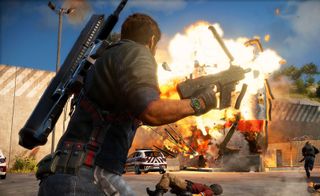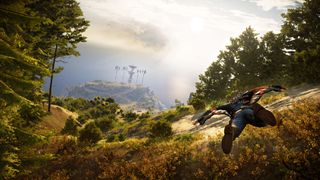Grappling with the chaos of Just Cause 3

This article was originally published in PC Gamer issue 276. For more quality articles about all things PC gaming, you can subscribe now in the UK and the US.
I'm looking at a piece of concept art pinned to a window in Avalanche’s Swedish studio. It shows a beautiful Mediterranean beach glowing in the afternoon sun. Then I look past it, out of the window, and see that it’s snowing heavily outside. It seems strange that a series famous for its tropical picture-postcard settings is made in Stockholm and New York: two cities known for their brutal winters. But then that’s what Just Cause is all about: escapism.
“Just Cause gives you that feeling of being twelve years old,” says Roland Lesterlin, game director. “You almost have the mind of an adult. You understand the world. But everyone’s taller than you. The moon is bigger. The stars are big. You get into a car and it’s big. It’s this sense of wonder and learning new things. New smells, new tastes. And games have a unique ability to give us that emotion.”
Just Cause 3, he says, is built with this feeling in mind. A world of possibilities that rewards inquisitive players, and coaxes you to prod and experiment with its systems. But at the same time, it’s not as wild as, say, Saints Row. This is intentional according to Lesterlin: “Compared to other open-world games, we push more towards the sandbox. But as outrageous as it is, we’re still grounded in reality in a lot of ways. Take the wingsuit. It feels real because it’s fast, and when you hit the ground it’s a little aggressive. But you can fly for long distances without losing momentum. I think when you get too absurd it damages your sense of escapism.”

The wingsuit joins the parachute and grappling hook as a means of getting around the massive map, and it’s a thrill to use. At any time during a grapple or parachute drop you can switch to it, and its physics are so ridiculously floaty that it almost feels like flying. Being able to transition between these three modes of transport makes traversing the new setting of Medici a joy.
The map is the same size as in the previous game, but I can tell instantly that it’s a more interesting environment in terms of layout and geometry. The area I start in features a town resting on the top of a cliff, a dramatic, rocky coastline with caves carved into it, and a huge enemy base like an oil refinery built into the side of a mountain. It feels much more sheer and vertical than the Panau of Just Cause 2: the perfect playground for the new wingsuit.
I spend a good chunk of my time with the game just floating around, soaring through rocky arches and under bridges. If you start to slow down, just grapple onto a nearby piece of scenery and give yourself a quick boost. Because that’s science.
PC Gamer Newsletter
Sign up to get the best content of the week, and great gaming deals, as picked by the editors.
The Just Cause games have always had stories, but they’re remembered more for their sandbox worlds. I ask Lesterlin if story is still important to them: “The sandbox came first,” he admits happily. “The narrative is fun too, of course. We had fun making it, and it’s silly and campy and we don’t take ourselves seriously. I hope people have fun with the story and meeting the new characters, but we really wanted to create that joyful sandbox first.”
If it’s set in space, Andy will probably write about it. He loves sci-fi, adventure games, taking screenshots, Twin Peaks, weird sims, Alien: Isolation, and anything with a good story.
Most Popular




